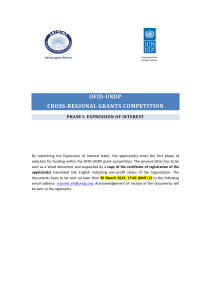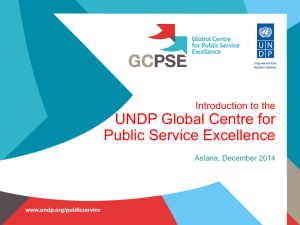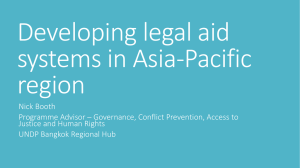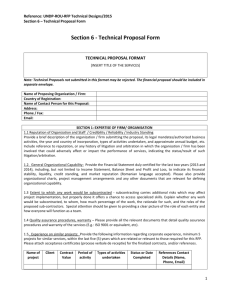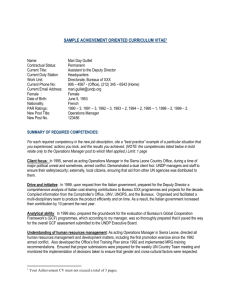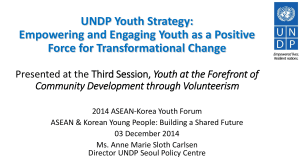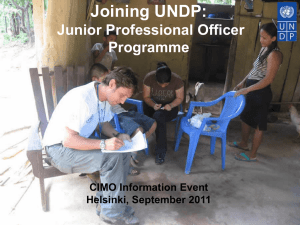English
advertisement
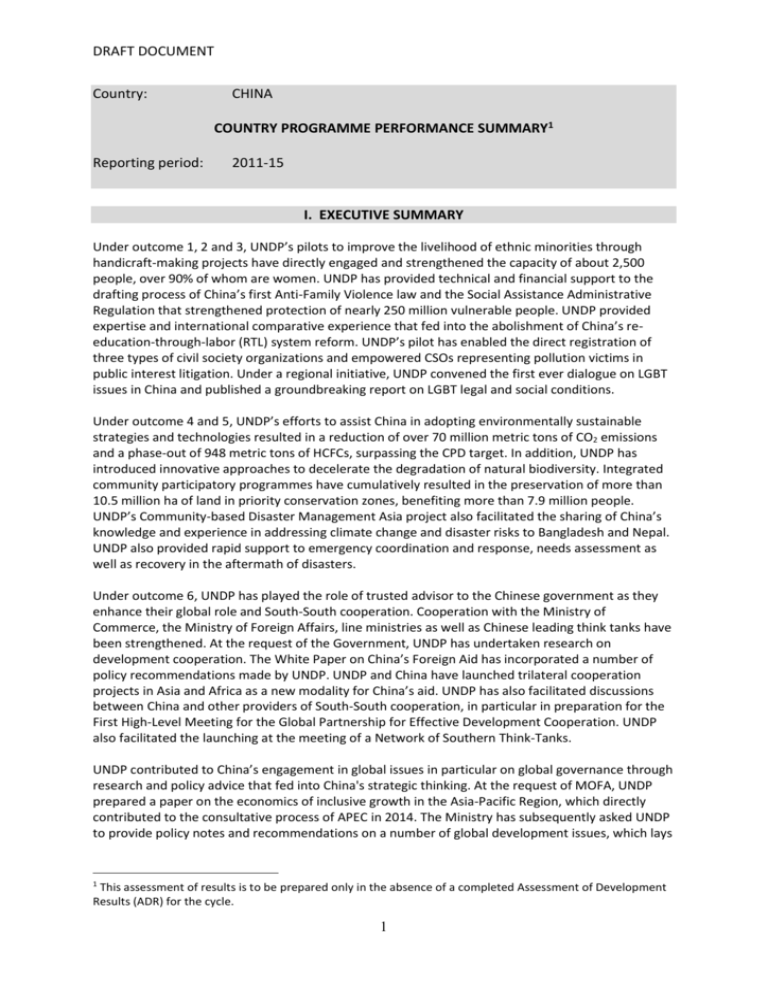
DRAFT DOCUMENT Country: CHINA COUNTRY PROGRAMME PERFORMANCE SUMMARY1 Reporting period: 2011-15 I. EXECUTIVE SUMMARY Under outcome 1, 2 and 3, UNDP’s pilots to improve the livelihood of ethnic minorities through handicraft-making projects have directly engaged and strengthened the capacity of about 2,500 people, over 90% of whom are women. UNDP has provided technical and financial support to the drafting process of China’s first Anti-Family Violence law and the Social Assistance Administrative Regulation that strengthened protection of nearly 250 million vulnerable people. UNDP provided expertise and international comparative experience that fed into the abolishment of China’s reeducation-through-labor (RTL) system reform. UNDP’s pilot has enabled the direct registration of three types of civil society organizations and empowered CSOs representing pollution victims in public interest litigation. Under a regional initiative, UNDP convened the first ever dialogue on LGBT issues in China and published a groundbreaking report on LGBT legal and social conditions. Under outcome 4 and 5, UNDP’s efforts to assist China in adopting environmentally sustainable strategies and technologies resulted in a reduction of over 70 million metric tons of CO2 emissions and a phase-out of 948 metric tons of HCFCs, surpassing the CPD target. In addition, UNDP has introduced innovative approaches to decelerate the degradation of natural biodiversity. Integrated community participatory programmes have cumulatively resulted in the preservation of more than 10.5 million ha of land in priority conservation zones, benefiting more than 7.9 million people. UNDP’s Community-based Disaster Management Asia project also facilitated the sharing of China’s knowledge and experience in addressing climate change and disaster risks to Bangladesh and Nepal. UNDP also provided rapid support to emergency coordination and response, needs assessment as well as recovery in the aftermath of disasters. Under outcome 6, UNDP has played the role of trusted advisor to the Chinese government as they enhance their global role and South-South cooperation. Cooperation with the Ministry of Commerce, the Ministry of Foreign Affairs, line ministries as well as Chinese leading think tanks have been strengthened. At the request of the Government, UNDP has undertaken research on development cooperation. The White Paper on China’s Foreign Aid has incorporated a number of policy recommendations made by UNDP. UNDP and China have launched trilateral cooperation projects in Asia and Africa as a new modality for China’s aid. UNDP has also facilitated discussions between China and other providers of South-South cooperation, in particular in preparation for the First High-Level Meeting for the Global Partnership for Effective Development Cooperation. UNDP also facilitated the launching at the meeting of a Network of Southern Think-Tanks. UNDP contributed to China’s engagement in global issues in particular on global governance through research and policy advice that fed into China's strategic thinking. At the request of MOFA, UNDP prepared a paper on the economics of inclusive growth in the Asia-Pacific Region, which directly contributed to the consultative process of APEC in 2014. The Ministry has subsequently asked UNDP to provide policy notes and recommendations on a number of global development issues, which lays 1 This assessment of results is to be prepared only in the absence of a completed Assessment of Development Results (ADR) for the cycle. 1 DRAFT DOCUMENT a solid foundation for UNDP’s prolonged strategic engagement in China’s evolving South-South cooperation. 2 DRAFT DOCUMENT II: Country Programme Performance Summary Country information Country name: CHINA Current country programme period: 2011-15 Outcomes Total Expenditure Key Indicators of outcome (1-4 per outcome) Progress made against key indicators 1. Deepen the reforms that address disparities, promote equitable distribution of public resources, and foster equal access to social services and livelihood support $ 48,422,000 a. a. b. Number of national strategy, plan, policy or programme addressing disparities and promoting equitable and inclusive growth support by UNDP Number of pilots/population in UNDP targeted areas promoting inclusive development, income generation of the poor, demonstrating effectiveness for upscaling or replication b. Some progress was made. Two national strategies to address disparities and promote equitable and inclusive growth which were supported by UNDP have been adopted in last 4 years. During programme period, the target was achieved. Ten pilots were developed in areas targeted by UNDP, promoting inclusive development, income generation of the poor and demonstrating effectiveness for scaling-up/ replication. UNDP Contribution: The government implementing partners, the State Ethnic Affairs Commission and the All China Women’s Federation, focused on culture-based livelihood development for ethnic minority women. This innovative public-private partnership increased the income of ethnic minority women, opened international markets for their products, strengthened community based women organizations and yielded policy impact and the replication of UNDP’s model in other ethnic minority areas. Government allocated additional resources to develop the ethnic minority women’s organizations and increased government procurement of the products. Through years of practice, the strengthened self-esteem and local capacity for handicraft production and organizational management ensured the achievement of outcome 1 and the sustained impact of the projects. Local government’s support to financial innovation in rural areas also enabled UNDP to carry out new pilots on rural cooperatives. CP Outputs: The UNDP CP identified three major outputs to support the Government in achieving this outcome: 1.1 The implementation mechanisms for equitable resource distribution and equal access to social services for poor communities and vulnerable groups (inc. the elderly, the disabled, and migrant workers) are strengthened; 1.2 Integrated approaches that provide poor rural communities with access to land, technology, financial services, and markets and that enable them to adapt to climate change are promoted; 1.3 Expand the implementation of culture-based development strategies for ethnic minorities. Progress and Achievements: As a result of UNDP’s introduction of a microfinance component, loans of around 500,000 RMB were provided to approximately 250 members of handicraft associations to purchase fabrics and small tools. The resultant increased employment opportunities have gradually attracted 358 migrant workers to return to their hometowns, enabling 3 DRAFT DOCUMENT them to reunite with 428 ‘left-behind’ children. UNDP has promoted equitable access to financial services in the central and western part of China. The nation’s first centres in Sichuan and Guizhou provinces were established by UNDP, focusing on developing integrated rural cooperatives which incorporate production, supply, marketing, and credit services for farmers in poor villages. In 2014 the centres have entered into cooperation with 62 rural cooperatives, providing access to finance and consultation services on agriculture production and business development for nearly 8,000 households. 2. Empower communities and civil society to participate in shaping China’s cultural and socio-economic development $ 9,639,000 a. b. Number of beneficiaries (communities and civil society) engaged in policy advocacy and capacity-building activities. Number of recommendations for policy and institutional changes produced in areas of promoting equal access to justice, civil society development, and a supportive legal framework to policy and legislative makers a. b. Significant progress has been made, 54 (30 LGBT; 20 HIV; 4 Tobacco) communities/ civil society organisations have been engaged in policy advocacy, and capacitybuilding activities have been implemented. Significant progress has been made against this indicator as well. 27 (20 LGBT; 7 HIV & law) recommendations were provided for policy and institutional changes made in the areas of: promoting equal access to justice, civil society development, and a supportive legal framework to policy and legislative makers. UNDP Contribution: UNDP has provided policy advices and international expertise in China’s efforts to “ruling the country according to the law” through its partnership with China’s legislature, judiciary, the executive branches and think-tanks. UNDP contributed to China’s 3rd Five-year Judicial Reform Plan of the Supreme People’s Court by piloting open trial, people’s assessors and judicial aid systems. Through collaboration with the National People’s Congress Legislative Affairs Commission, UNDP’s pilot increased public participation in law-making and improved legislative review system that ensured legislation harmonization. UNDP provided technical and financial support to the drafting process of China’s first Anti-Family Violence law and the Social Assistance Administrative Regulation that strengthened protection of nearly 250 million vulnerable people. UNDP provided expertise and international comparative experience that fed into the abolishment of China’s re-education-through-labor (RTL) system reform. UNDP’s pilot has enabled the direct registration of three types of civil society organizations and empowered CSOs representing pollution victims in public interest litigation. The ability of UNDP to be considered an honest broker and independent partner helped in strengthening existing partnerships in this area of work. CP Outputs: The UNDP CP identified two major outputs to support the Government in achieving this outcome: 2.1 The scope for civil society participation in policy dialogues, in the empowerment of communities, and ensuring that the vulnerable groups (elderly, disabled, persons with HIV/AIDS, and migrant workers) equal access to social services is broadened; 2.2 The design and implementation of legal reforms that promote the rule of law, equal Access to Justice, and public accountability is supported. Progress and Achievements: 4 DRAFT DOCUMENT UNDP’s contribution to governance for equality and participation combined two mutually reinforcing approaches, a top-down one by supporting governance reforms and building responsive institutions and a bottom-up one by empowering vulnerable groups and civil society and support their inclusion in policy making processes. Following its contribution to the policy dialogue that ultimately led to the abolishment of the Re-education Through Labor System (affecting 60,000 people in 350 camps countrywide) UNDP continued to carry out policy research to inform further reforms on the actual implementation arrangements for this change. UNDP facilitated a SSC exchange with Vietnam and submitted findings on lessons learnt from Vietnam’s abolishment of its own administrative sanctions system to policymakers. UNDP published an Annual report on China’s Judicial Reform which provided key policy recommendations for further judicial reforms within the framework of the new Judicial Reform FiveYear-Plan. UNDP supported the first civil society Shadow Report on LGBT issues to be submitted by Chinese LGBT communities to CEDAW. The report was mentioned by the CEDAW Committee and led the Government to publicly address issues of Sexual Orientation and Gender Identity (SOGI) for the first time. UNDP provided inputs to the first national law review on HIV and key populations, leading to a national report being submitted to an intergovernmental meeting at UNESCAP 3. The right of women to greater $ 2,763,000 a. Percentage of women in village a. There is some progress. The percentage of women in village social and political participation committees and in the National People’s committees and in the National People’s Congress was and to live lives free from Congress; increased by 2 percent. discrimination and violence, and b. Prevalence of domestic violence against b. The prevalence of domestic violence against women remains is advanced. women. unchanged. UNDP Contribution: While UNDP has supported China in making progress to improve women’s political participation and protect women from gender-based violence, change has been less significant than the targets set for this outcome. UNDP’s work on gender is faced with challenges from the external political environment, as well as its internal positioning and planning on gender issues. The China-specific political context has been the major factor hindering UNDP’s efforts to promote greater participation by women in political and social affairs. CP Outputs: The UNDP CP identified three major outputs to support the Government in achieving this outcome: 3.1 The effective participation of women in political decision-making at the sub-national level is expanded; 3.2 The implementation of the current policies, laws, regulations that affect the sex ratio at birth is strengthened; 3.3 The implementation of the current policies, laws, regulations addressing discrimination and violence against women is strengthened. Progress and Achievements: In the 12th National People's Congress, the percentage of female representatives has increased to 23.4%, 2% higher than the previous term. UNDP’s financial support and technical trainings to Chinese Academy of Governance has resulted in gender mainstreaming in the official curriculum for and systematic trainings given to civil servants nationwide. The UNDP-supported knowledge product draft of the first civil servant textbook on gender mainstreaming will be used in 300 mandatory classes influencing 15,000 civil servants per year. Through a new partnership with Chengdu municipal government, UNDP conducted the Gender and Economic Policy Management Initiative Training to 50 government officials from key planning and economy management sectors. In UNDP-supported ethnic minority Handicraft Associations, 90% of decisionmaking positions were held by women compare to 0% at baseline. This empowerment, combined with UNDP technical and leadership training has inspired several beneficiaries to run for local elections, with one successfully elected as representative to both the Country-level and Municipal-level People’s Congress. 5 DRAFT DOCUMENT 4. Low carbon and other $ 136,727,000 a. Cumulative CO2 emissions reductions a. Cumulative CO2 emissions reductions have reached 72 environmentally sustainable from 2011-2015; million tons (nearly 50 million in 2014) strategies and technologies are b. Hydrochlorofuorocarbons (HCFC) b. HCFC consumption was reduced by 948 metric tons in the adapted widely to meet China’s consumption reduction by 2015. last 4 years under UNDP-supported projects. commitments and compliance with Multilateral Environmental Agreements UNDP Contribution: The outcome was achieved in 2014 as planned. Policy work related to environmentally sustainable strategies and technologies aimed at meeting China’s commitments and compliance with Multilateral Environmental Agreements was at the forefront of UNDP’s work. The completed special medium- and long-term plan for Energy Standard and Labeling (ES&L) promotion, the approved policy framework and implementation scheme of the China Top-Runner Energy Efficiency System and the low carbon products standards and associated Green House Gas (GHG) accounting methodologies introduced for six products are all key policy changes to which UNDP directly contributed. CP Outputs: The UNDP CP identified two major outputs to support the Government in achieving this outcome: 4.1 Policy and capacity barriers for the sustained and widespread adoption of low carbon and other environmentally sustainable strategies and technologies removed; 4.2 Capacity to implement local climate change action plans for mitigation and adaptation, and sustainable development built. Progress and Achievements: UNDP support led to the successful elimination of 72 million tons of CO2 emissions. HCFCs have been reduced by 948 metric tons. The efficient Public-Private Partnerships (PPP) that UNDP formed with 93 companies ensure sustainable strategies and commercially feasible technologies. UNDP projects have offered 46 different Climate Change-related trainings to further support outreach and public awareness of local implementation actions. 5. The vulnerability of poor $ 52,802,000 a. Increase in individual and institutional a. The available data from Gansu and Huaihe projects communities and ecosystems to capacity for conservation biodiversity and produced five capacity scores, which on average increased climate change is reduced sustainable land use and use of natural 29.9% on baseline (range 17.9% - 41.45%) resources; b. Increase in number of pilot community b. 8 villages from Qinghai adopted community coand coverage of areas benefitting from management plans and expanded protection to 375414.14 UNDP supported integrated wetland ha of wetland protected areas. protection, disaster risk reduction and resilience building approaches. UNDP Contribution: The progress was made with a series of positive changes occurring under the portfolio. Importantly, efforts towards ensuring long-term financial sustainability of Protected Areas (PA) progressed well, in particular with the financing plan for the PA system in Gansu. The progress in the development of local action plans such as the biodiversity-friendly Master plan (2010-2020) for Xinyang Municipal Government and the development of a co-management plan for 12 pilot villages in Qinghai (Qinghai, 6 DRAFT DOCUMENT APR) are two examples of impactful UNDP interventions with regard to local planning process and engagement. Equally importantly, policy work under this outcome has achieved tangible progress. UNDP advocated for community-based disaster risk management and influenced China’s shift from top-down approaches to more participatory, locally based conceptions of disaster risk reduction. The National Plan for Comprehensive Disaster Reduction and Prevention (2011-2015) and the first national Guidance Note on Strengthening Community-based Disaster Reduction are key national strategies that benefited from UNDP supported multi-year initiatives of policy research, community pilots and capacity building initiatives. Over one hundred million Chinese citizens, primarily the poor and ethnic minorities, benefitted from this major policy shift. CP Outputs: The UNDP CP identified two major outputs to support the Government in achieving this outcome: 5.1 A strengthened policy, legal, institutional framework for the sustainable use of land, water, the conservation of biodiversity, and other natural resources in fragile ecosystems is enforced; 5.2 The integration of gender, vulnerability assessments, risk reduction and adaptation to climate change into local development planning and service delivery in support of poor communities is promoted. Progress and Achievements: The biodiversity-friendly Master Plan 2010-2020 for Xinyang Municipal Government was developed by local government official and supported by project-financed national experts. It incorporated land use regulations for more than 135,000 ha of a priority conservation zone, which increased water retention and carbon sequestration while decreasing soil erosion and pressures on biodiversity, thereby securing a better environment for 7.9 million people. The development of 12 community comanagement plans in Qinghai province covered nearly 1.5 million ha of land under sustainable management. UNDP biodiversity projects resulted in a total of 9 million ha of land in China becoming protected in 2014. The introduction of sustainable biodiversity-friendly alternative livelihoods for poor local communities and practical mechanisms to mainstream biodiversity helped China increase its resilience towards climate change. UNDP also engaged in capacity building and awareness raising by training 2,433 personnel in biodiversity conservation, and 30,000 more people this year have learned the importance of biodiversity and sustainable use of resources. UNDP further facilitated South-South Cooperation in disaster management. Approximately 1,000 government officials, members of academia and community staff from 5 Asian and African countries joined exchange programs together with their Chinese counterparts. 6. Deepen China’s engagement and participation in global and regional development partnerships to realize the MDGs and to address climate change $ 14,008,000 a. b. Number of High level dialogues and partnership arrangements at cross country level, or regional and global levels implemented to promote socioeconomic cooperation and inclusive development; Increase in number of people from other developing countries benefiting from UNDP supported exchanges and demand- 7 a. b. There are 8 more High level dialogues and partnership arrangements at cross country level, regional and global levels implemented to promote socio-economic cooperation and inclusive development since 2010, which met the target. 501 people from other developing countries participated in UNDP supported exchanges and demand-driven training programmes to share China’s development experiences. DRAFT DOCUMENT driven training programme sharing China’s development experiences. UNDP Contribution: Because UNDP has operated in China for more than three decades, we have developed a deep level of trust with the Chinese government and understanding of Chinese society. In addition, the Government is increasingly open to cooperation with other actors at different levels, and seeking to produce positive impacts on global development issues. Specifically in 2014, UNDP took strong and deliberate action to further develop relationships with key Chinese counterparts, including government ministries, influential think tanks and CSOs, and prominent universities that are active in policy work, and was able to provide policy advice and feed into the policy-making process through these networks. Due to initial financial support from UNDP Headquarters (FCEPI), we were able to invest into policy advice and projects, employ staff that could work closely with Chinese decision-making bodies and government-affiliated institutions, and keep track of China’s shifting policies, most pressing needs and economic and social transformation. In all our work we stressed the fact that UNDP respects key international and south-south cooperation principles of equality, mutual respect, country ownership and demand-driven interventions, and we aligned our strategy with China’s priorities and UNDP’s specialist areas. We maintained our neutrality and paid attention to sensitivities in all aspects of the engagement with China and other partners, and therefore enhanced mutual trust. CP Outputs: The UNDP CP identified two major outputs to support the Government in achieving this outcome: 6.1 China’s role, contribution and participation in regional and cross-border development partnerships is enhanced; 6.2 Mechanisms for South-South cooperation, trilateral partnerships and purchasing power parity that facilitate the sharing of China’s knowledge, technology and experience in addressing poverty and climate change, disaster risk reduction, are deepened. Progress and Achievements: UNDP China mobilized USD 5.2 million from Denmark and renewable energy TrC projects between China and Ghana/Zambia were signed. To promote regional cooperation the China-Bangladesh Urban Solutions Lab (developed with APRC) exchanged knowledge on municipal social service provision. In March, the China-India Low Carbon report was presented at the Third China-India Strategic Economic Dialogue in the presence of the Chairman of the National Development and Reform Commission and officials responsible for both China and India’s five-year planning processes. In Africa, UNDP with the International Poverty Reduction Center in China facilitated the 2014 China-Africa Conference on poverty reduction, development and new industrial development opportunities. A public service video on low-carbon lifestyles was launched at the China Low Carbon Week and played on CCTV for three nights. At the policy level, China’s second White Paper on Foreign Aid released in 2014, incorporating a number of policy recommendations that UNDP had made to the Government. 3 scoping papers provided an academic framework for the Second HighLevel Forum on Global Governance. UNDP and the Government co-organized a second national consultation and a workshop to update both Government and Civil Society on the post-2015 development agenda in preparation for China’s participation at the 70th General Assembly. Summary of evaluation findings (e.g. from outcome and project evaluations, UNDAF reviews, and other assessments) Based on the CPD Review undertaken in September 2014, below is a brief summary of the overall findings on the CP over 2011-2014: 1. UNDP remains the Government’s primary development cooperation partner and has shown the flexibility to adapt, evolve and strengthen technical capacities in order to respond to the changing context of development cooperation and emerging demands. 8 DRAFT DOCUMENT 2. 3. 4. The Government with its growing emphasis on South-South cooperation (SSC) particularly values UNDP’s global presence, and the institution’s network of Country Offices. China’s new emphasis on being a key global presence, a knowledge hub for sharing lessons as well as deepening SSC, merges seamlessly with UNDP’s comparative advantages. Thought should be given to promoting SSC as a crosscutting issue during the next cycle for most outcome areas. With UNDP also moving towards providing more ‘upstream’ and policy advisory services to its government counterparts, it appears that the Government would like UNDP to advise and work with them in the future on large reformative, innovative ideas and initiatives. With regard to programme implementation as a whole, the review team found that given all of the challenges outlined, the programme has responded well and contributed positively to China’s development priorities. Key Achievements: 5. Outcomes related to Poverty and Governance made significant contributions in over-turning unjust laws and in general helped build capacity and promote reform in the judicial and civil society areas. The Outcome related to Poverty performed exceptionally with regard to influencing policy on social safety nets as well in working with ethnic minorities. 6. Outcomes 4 and 5, were deemed by the review team to have comparably achieved the greatest impact if one takes into account the amount of resources delivered, and projects implemented as well as positive impacts on policy and capacity building at national and local levels. 7. With respect to Disaster Risk Management, a large proportion of UNDP’s work took place after tumultuous events like the 2008 earthquake, particularly with respect to response mechanisms. Lessons were learned, which have now been incorporated into programming at both policy levels, especially with regards to building capacity for resilience at local level, with pilots being utilized to upscale lessons. Disaster management as currently programmed in some areas (such as the work done in conjunction with DFID and involving Nepal and Bangladesh) could also be seen through the lens of South-South Cooperation. Major Lessons Learnt: 8. Some outcome areas appeared to have some overlaps in terms of programming, which made reporting on results unclear. Activities in both these outcome areas displayed both ‘downstream’ as well as ‘upstream’ work—a lesson perhaps that UNDP cannot always simply position itself as an ‘upstream’ agency, and that such nomenclature should be identified on a case by case basis. 9. The Outcome area for Gender had the least amount of visibility or contribution. There could be several reasons for this, one being that the Outcome language itself as reflected in the CPD--‘the right of women to greater social and political participation is advanced’, could be seen as too vague, while its related indicators and targets were difficult to verify due to reliance on government statistics. The review team recommended that serious thought be given to mainstreaming gender throughout the various programme areas, rather than continue to maintain its status as a separate outcome. Further, this mainstreaming should be captured in a stronger more results-oriented fashion in the next cycle. Focus Area III. Country Programme Resources Programme Expenditure ($) Regular (TRAC) Poverty eradication and achievement of internationally agreed development goals, including the MDGs (CPD Outcome 1, 6) $ 9,271,000 9 Other $ 53,159,000 % of Total Total $ 62,430,000 TRAC/Total 14.85% DRAFT DOCUMENT Democratic Governance (CPD Outcome 2) Gender equality and the empowerment of women (CPD Outcome 3) Environment and Sustainable Development (CPD Outcome 4,5) Total $ $ $ $ 2,335,000 494,000 5,856,000 17,956,000 Data sources: (please indicate the main sources from which data were obtained for this report.) CPD 2011-2015 CPD Review Report ROAR 2011, 2012, 2013, 2014 UNDP Project Annual Progress Reports Project Evaluation Reports 10 $ $ $ $ 7,304,000 2,269,000 183,673,000 246,405,000 $ $ $ $ 9,639,000 2,763,000 189,529,000 264,361,000 24.22% 17.88% 3.09% 6.79%



